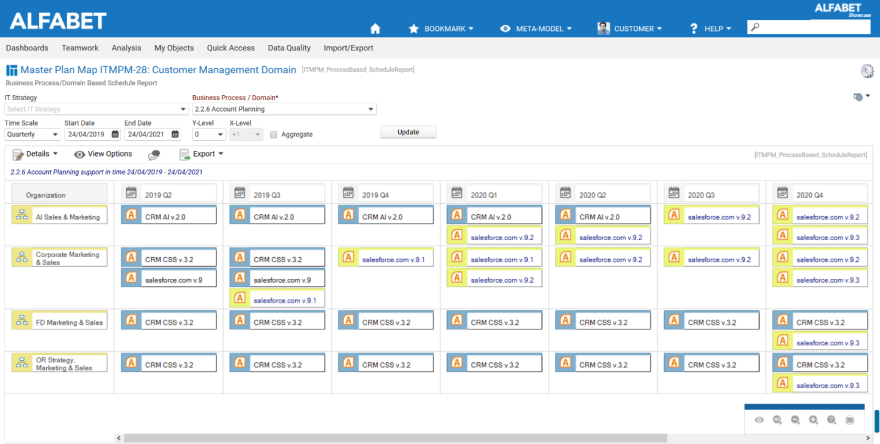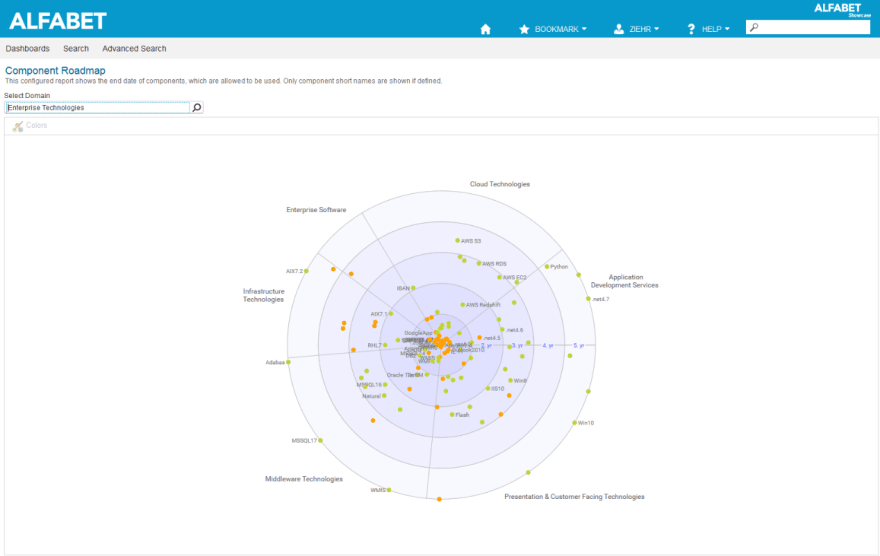This is part 5 and the final chapter of our series on roadmapping in enterprise architecture, IT planning and portfolio management.
The main takeaway on IT road mapping is that it’s going to help your IT organization manage the growing complexity of technology effectively and efficiently, in order to be able to deliver products and services to business more reliably.
Specifically, your organization will be able to see:
- Efficiency gains: Information needs to be managed. Building an information management discipline on a consistent methodology will save time and allow staff to focus on more valuable activities, such as how to change business capabilities and processes
- Project improvement: By aligning the IT change portfolio with the business strategy portfolio, projects have a clear mission, scope, champion and timing. Project success is much more likely.
- Reduction in the operational budget: Better coordination of IT services with business demand will enable IT to better assess needed service level agreements and adjust them accordingly, creating potential for operational cost cutting.
As your organization progresses in its IT road mapping, it will develop the capacity to predict, measure, and manage the time to react to predictable and unpredictable events.
Let’s review the different aspects of road mapping we looked at in this series of articles.
What is a road map?
Forrester defines six key elements of a road map:
- A time frame that reflects the organization’s expectation of outcome delivery.
- Prioritized and identifiable outcomes.
- Strategic themes that provide clarity for prioritization.
- Context-specific road map content that reflects stakeholder needs.
- Clarity on dependencies that may affect the delivery of the outcomes.
- Transparent investment outlay during the time frame.1
Road maps let you know the following:
- Velocity of change
- Decision points
- Event sequencing
- Dependencies
- Future risk
Road maps can have varying forms. Most importantly, when deciding on how to configure a road map, it is best to think of what you want the intended audience to understand. Below are a few examples:
- If the goal is better business collaboration, the road map should link business strategy and the need for capability improvement to IT deliverables.
- If cost reduction is the highest priority, the road map should help disentangle the current project portfolio by identifying overlapping, redundant or outright conflicting projects.
- A consolidation initiative will need road maps to be able to link the technology portfolio to application usage, identify rationalization road maps for the technology portfolio and translate these into application changes.
- To promote agility, road maps will harmonize context processes and the IT solutions supporting those across the organization resulting in faster time-to-market for changes requested by business.
- For clear instructions to the Operations and Infrastructure group as to the precise timing of technology changes, migration road maps clearly show the plan.
Figure 1: Road maps coordinate change between interconnected portfolios.
Why are road maps useful?
Road mapping helps an IT organization carefully calibrate the different IT projects and plans across a dispersed IT organization. This helps avoid conflicts that can cause project overruns and ultimately result in higher costs. Road maps are essential while consolidating IT landscapes – something so many IT organizations are concerned with today, whether the result of an M&A, a proliferation of applications and technologies, or negligence in timely retiring unused systems. In consolidation initiatives, road maps ensure the precise timing of shutting down applications, rolling over to new technologies and introducing new IT support for business.
Most importantly, road maps help IT align with business. Road maps:
- Provide a common language between business and IT to be able to communicate sudden changes to plans throughout an increasingly complex organizational setup
- Show the activities and timing of various projects to make sure IT projects don‘t adversely affect business project delivery
- Lend transparency to IT plans to ensure that business project plans aren‘t built on false assumptions about what IT can deliver
- Demonstrate progress on delivering to a business strategy
Figure 2: Road map of the support of the Business Capability (Domain) ”Customer Management” by applications across locations - differentiated by actually approved applications (blue) and proposed tactical plans (yellow).
How do you create effective road maps?
We talked about three main principles for creating effective road maps:
- Be consumer-centric.
- Keep the presentation simple.
- Interrelate roadmaps into a network of dependencies.
Gartner provides the following recommendations:
- Create road maps that focus on decision-making needs and styles to aid stakeholders in visualizing future business outcomes, enabling them to make better-informed investment decisions.
- Socialize road maps at the earliest possibility to ensure that they meet stakeholder expectations, are usable and useful, and contain the right level of detail.
- Develop road maps that weave business and IT capabilities together in a way that aids stakeholders in visualizing future business outcomes and making better-informed investment decisions.
- Review and update road maps on both a calendar cycle and in response to the ecosystems, business and technology-critical disruptions.
- Devise road maps that clearly show the transition to the future state from the current state, always acknowledging that road maps are abstractions that should be kept as simple as possible.2
We see that a common theme is to always have the audience in mind.
Figure 3: This circular roadmap for technology portfolio managers and solution architects shows technologies positioned on a time-axis according to their end-of-life dates. The colors indicate whether they are free for use (green) or need approval (orange). The graph is sectioned according to technology category.
What are the technology requirements for effective IT road mapping?
- Ability to interconnect related road maps
- Ability to ensure optimum data quality
- Ability to make road map maintenance a by-product of daily planning tasks
- Ability to address the various consumers of road maps
As an integrated IT portfolio management and planning tool, Alfabet is ideally equipped to fulfill these requirements. It enables creation of relationships between all the architecture artifacts in its repository and even relationships at the portfolio level. By associating life cycles and status to all artifacts as part of object capture, it automatically builds the time-based aspect necessary for a road map. The wealth of data in its repository as well as the ability to create many different styles of road maps ensures that stakeholder needs and preferences can be catered to.
What are some best practice examples?
- Standardize the visualizations and semantics which business and IT use for collaboration.
- Use a central inventory of plans to re-use the current architecture information (applications, support, processes etc.)
- Train business users to create planned (desired) IT support with a desired lifecycle.
- Use road maps as mandatory documents for planning meetings and input for detailed IT delivery plans.
- Establish guidelines for changing road maps.
- Apply rules to road maps for governance (e.g. govern component migration stages)
- Make project approval dependent on inclusion in the master plan road map.
- Use blueprints to create consistent and standardized guidelines across separate organizations (e.g. in setting up a new manufacturing plant or sales organization)
- Keep road maps visible
And Gartner advises the following:
Avoid too much detail:
- Don’t present technical views
- Circumvent representing road maps as a hard-and-fast plan
- Avoid wishful thinking and speculation
- Gather consensus around goals
- Prioritize around priorities3
Figure 4: Road map of the projects that affect an application domain (Back Office) showing the project lengths (in blue) and the application lifecycles.
Conclusion
We started this series with a quote from Earl Nightingale, (an American motivational speaker, 1921 - 1989) “All you need is the plan, the road map, and the courage to press on to your destination.” Well, you’ll have to figure out the plan and find the courage to follow it yourself but hopefully this series has helped you better understand the significance of the road map.
1 Use BT Road Maps To Drive Strategic Portfolio Management, by Margo Visitacion, Forrester Research, December 20, 2018
2 Create Roadmaps That Support Decision Making and Communicate Strategy Effectively, by James McGovern, Gartner, February 3, 2020
3 Create Roadmaps That Support Decision Making and Communicate Strategy Effectively, by James McGovern, Gartner, February 3, 2020










Top comments (0)